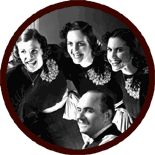"Bei Mir Bist Du Schoen"
The story of this tune's stratospheric rise is as unlikely as that of Yiddish
swing itself. “Bei Mir Bist Du Schoen” was composed by Sholom Secunda
for a 1932 Yiddish musical that opened and closed in one season. Fast-forward
to 1937. Lyricist Sammy Cahn and pianist Lou Levy were catching a show at the
Apollo Theater in Harlem when two black performers called Johnnie and George
took the stage singing "Bei Mir Bist Du Schoen" -- in Yiddish. The
crowd went wild. Cahn and Levy couldn't believe their ears. Sensing a hit, Cahn
convinced his employer at Warner Music to purchase the rights to the
song from the Kammen Brothers, the twin-team music entrepreneurs who had bought
the tune from Secunda a few years back for the munificent sum of $30.
Cahn gave "Bei Mir" a set of fresh English lyrics and presented it
to a trio of Lutheran sisters whose orchestra leader, oddly enough named Vic
Schoen, had a notion of how to swing it. The Andrews Sisters' debut 78 rpm for
the Decca label hit almost immediately. The era of Yiddish swing had begun.
"Bei Mir" would soon be covered by virtually every pop and jazz artist
of the age, and was even retranslated into French, Swedish, Russian -- and German.
(The song was a hit in Hitler's Germany until the Nazi Party discovered that
its composer was a Jew, and that the song's title was Yiddish rather than a
south German dialect.)
The song's success also sparked frenzied searches for other Yiddish crossover
hits. Some attempts, like "Joseph, Joseph" ("Yosl, Yosl"),
by the team of Chaplin and Cahn for the Andrews, and "My Little Cousin"
("Di Grine Kuzine"), by Benny Goodman, found modest success. But no
Yiddish song would ever hit it as big again.
Sammy Cahn claimed that he bought his mother a house with money earned from
"Bei Mir." For her part, the mother of Sholom Secunda visited the
synagogue every day for a quarter century to ask God for forgiveness, certain
that he was punishing her son for a sin she had committed.


